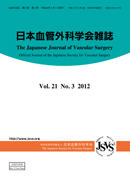Volume 21, Issue 6
Displaying 1-14 of 14 articles from this issue
- |<
- <
- 1
- >
- >|
-
2012Volume 21Issue 6 Pages i-ii
Published: October 25, 2012
Released on J-STAGE: October 30, 2012
Download PDF (253K)
Original Articles
-
2012Volume 21Issue 6 Pages 703-707
Published: October 25, 2012
Released on J-STAGE: October 30, 2012
Download PDF (257K) -
2012Volume 21Issue 6 Pages 709-715
Published: October 25, 2012
Released on J-STAGE: October 30, 2012
Download PDF (2204K) -
2012Volume 21Issue 6 Pages 717-720
Published: October 25, 2012
Released on J-STAGE: October 30, 2012
Download PDF (197K) -
2012Volume 21Issue 6 Pages 721-724
Published: October 25, 2012
Released on J-STAGE: October 30, 2012
Download PDF (266K)
Case Reports
-
2012Volume 21Issue 6 Pages 725-728
Published: October 25, 2012
Released on J-STAGE: October 30, 2012
Download PDF (579K) -
2012Volume 21Issue 6 Pages 729-732
Published: October 25, 2012
Released on J-STAGE: October 30, 2012
Download PDF (749K) -
2012Volume 21Issue 6 Pages 733-735
Published: October 25, 2012
Released on J-STAGE: October 30, 2012
Download PDF (822K) -
2012Volume 21Issue 6 Pages 737-740
Published: October 25, 2012
Released on J-STAGE: October 30, 2012
Download PDF (674K) -
2012Volume 21Issue 6 Pages 741-744
Published: October 25, 2012
Released on J-STAGE: October 30, 2012
Download PDF (1380K) -
2012Volume 21Issue 6 Pages 745-748
Published: October 25, 2012
Released on J-STAGE: October 30, 2012
Download PDF (680K) -
2012Volume 21Issue 6 Pages 749-751
Published: October 25, 2012
Released on J-STAGE: October 30, 2012
Download PDF (541K) -
2012Volume 21Issue 6 Pages 753-756
Published: October 25, 2012
Released on J-STAGE: October 30, 2012
Download PDF (770K) -
2012Volume 21Issue 6 Pages 757-761
Published: October 25, 2012
Released on J-STAGE: October 30, 2012
Download PDF (957K)
- |<
- <
- 1
- >
- >|
